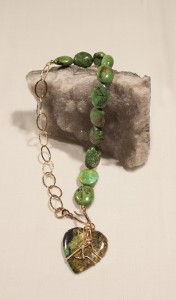“Personality and jewellery will conquer everything.” (Zandra Rhodes, internationally-renowned British fashion designer and also known for her pink hair)
Wearing this necklace made with huge Turquoise and Lapis Lazuli stones won’t help you leap tall buildings in a single bound or vanquish demons, but it will make you feel pretty special. And yes, maybe even unconquerable.

Both stones are so regal – the clours, the cuts – and I thought pairing the stones with a gold-coloured clasp and gold-coloured vintage beads added to the majesty of the piece. I made it asymmetrical – the clasp is worn to the side – to add to the uniqueness of the piece.
The necklace below is Turquoise too. This asymmetrical piece has Turquoise on one side and hammered gold-filled oval link chain on the other side. It’s finished off with a Turquoise heart pendant hanging on a gold-filled hammered ring. The heart is wrapped with gold-filled wire, and the hook clasp is hand-made. The stones in this piece are a beautiful green while the Turquoise in the necklace above is blue.

In this close-up of the heart pendant, you can see the detail of the wire wrapping.

The colours running through the Turquoise are black, different shades of green, brown and a wonderful sandy beach colour. I got the turquoise pieces for this necklace – the heart and the ovals – at two different places at different times but they’re a great match.
Trapping
From high fashion jewellery to the wilds of northern Ontario – have I mentioned that my dad was a trapper?
When I was young, my dad would pack a pail of creamy honey, a pail of strawberry jam, a pail of Tenderflake lard, 5 pounds of sugar, 5 pounds of flour, some salt pork, oatmeal and a few bags of cookies – usually oatmeal cookies. Oh – some tea, loose tea, not bags. Into a duffle bag would go his long underwear, heavy checked shirts, white T-shirts and several pairs of woolly grey work socks. Us kids knew it was time for him to go trapping and sometimes, he’d take his dog Skippy, a German Shepherd.
My dad would get on the train and we knew it would be several weeks before we’d see him again. When I was little, I never knew exactly where he was going, never knew exactly where his trapline was located. I’d hear him and my mom talk about this place called Bisco which seemed very exotic to me. So I knew that name and I knew it must be far because once he reached his destination on the train, the Lands and Forests Department would fly him somewhere else. This was long before the days of snowmobiles.
Here’s the cabin (or shack) that was his home base near Chapleau Ontario. And that’s my dad, Art Nahwegahbow standing in front of it. It was a modest one-room cabin with a pot-bellied wood stove and nails to hang your clothes. My dad put it together himself with logs and scraps of wood he found in the area.
 But, and I only learned this a few years ago, it’s a cabin that provided a safe haven for a Lands and Forests officer who was being pursued by a pack of wolves. I met a man whose father had known my dad years ago and he told me this story.
But, and I only learned this a few years ago, it’s a cabin that provided a safe haven for a Lands and Forests officer who was being pursued by a pack of wolves. I met a man whose father had known my dad years ago and he told me this story.
His dad was a Lands and Forests officer working for the Ontario provincial government. The area around Bisco was part of the territory he patrolled, doing what these officers do (like counting trees, checking the wildlife, catching poachers, or illegal trappers and fishermen, etc.).
One night – and it was a cold winter night, the kind you get only in the north – his dad was travelling by foot on the iced-over lake returning to his base camp. The only sound was the crunch of his boots as they hit the crisp snow and the only light was coming from the full moon. He was drinking in the cold air, enjoying the solitude when suddenly, he felt like he wasn’t alone. Sure enough, when he looked to his right he saw that he had company. A pack of wolves on the shore, maybe five or six of them, who had crept up ever so silently behind him. He didn’t have a weapon and he knew he’d never be able to outrun them. Inside his heavy parka, he began to sweat and he fought to stay calm as he began to imagine the feel of the wolves’ sharp teeth on his legs bringing him down. He kept on walking, quickening his pace slightly, but he didn’t dare run. He’d seen what happened to deer who tried to run from wolves. He struggled to get his bearings as he walked, his breath getting heavier, every once in a while glancing at the wolves. They continued to follow him but they kept their distance sensing it wouldn’t be long before they got their prey. When he finally got his bearings, he remembered my dad’s shack was not too far along. As long as he kept calm, he knew he’d make it. He saw the light from my dad’s shack and only then did he feel safe enough to start running. When he reached my dad’s door, he looked back at the wolves and they looked at him before they turned and loped back into the woods.
Over the years, I’ve met many people who knew my dad back in those days and I always enjoy hearing their stories.
But back to Bisco which is a short form for Biscotasing. Biscotasing is a community in the Unorganized North Part of Sudbury District in Northeatern Ontario. This small community, founded in 1884 as a railway construction town by Canadian Pacific Railway, is 140 miles northwest of Sudbury Ontario. When it ceased functioning as a railway town, it became a fur trading town and then a major centre for lumbering. Square lumber produced there was exported to Britain.
And there was another connection to Britain. Archie Belaney spent time at Biscotasing. Belaney was an Englishman who came to Canada in the early 1900’s, adopted a Native identity and called himself Grey Owl. He lived in the wilds, learning hunting and trapping techniques from First Nations people, but under the influence of a Mohawk woman with whom he fell in love, he became a conservationist. He became well known as an author and environmentalist on the lecture circuit. And no one ever guessed he was an Englishman! It was only after his death that his identity was publicly exposed.
Bisco has become something of a ghost town. The year-round population these days is 22 although this shoots up in the summer to about 300 because of the tourists.
Here’s another picture of my dad. This is one of my favourite photos of him. He quit trapping in the early 1960’s when he was elected Chief of Birch Island. A friend of mine once asked him why he hadn’t passed his trap line on to one of his sons. My dad replied,” I never wanted any of my kids to have to work as hard as I did.”
Next time – more jewellery and President Roosevelt’s trip to my community, Birch Island.

Leave a Reply